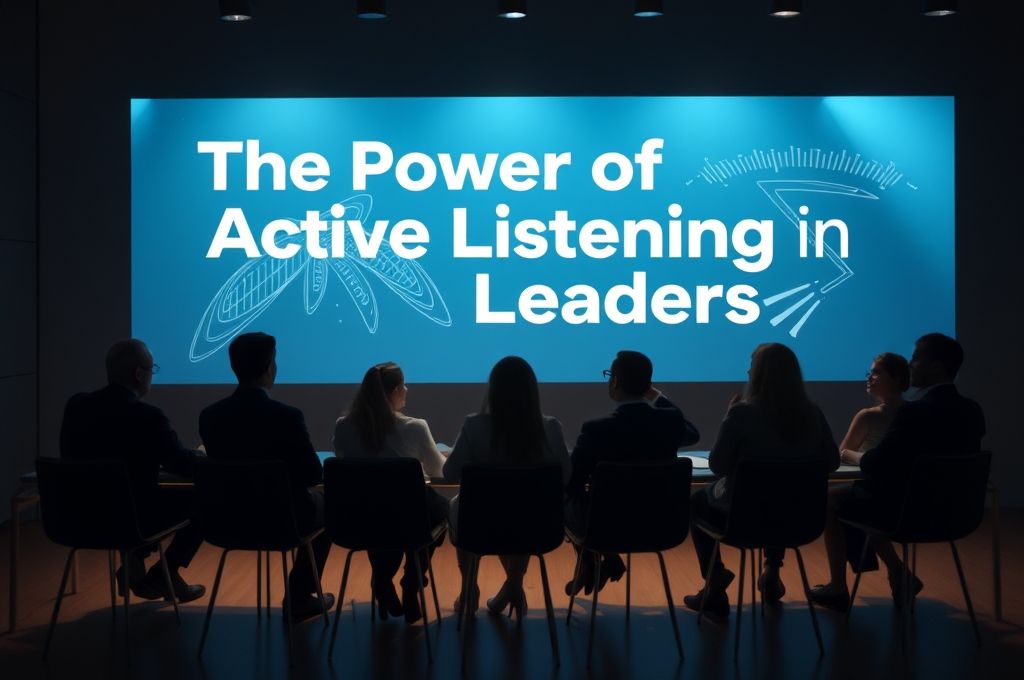Introduction: The Quiet Superpower of Great Leaders
Imagine a leader who doesn’t dominate every meeting, doesn’t interrupt, and doesn’t rush to give answers. Instead, they listen—deeply, attentively, and with genuine interest. Surprisingly, this quiet trait might be one of the most powerful tools in leadership: active listening.
In a world that often celebrates charisma, decisiveness, and fast action, the ability to truly listen can be overlooked. Yet, research shows that leaders who practice active listening build stronger teams, foster innovation, and inspire greater loyalty. According to a study by Gallup, employees who feel heard are 4.6 times more likely to feel empowered to perform their best work. That’s not just a statistic—it’s a game-changer.
This article explores why active listening is far more than just “being quiet while someone else talks.” It’s a skill—a discipline—that transforms how leaders connect, make decisions, and lead with empathy. We’ll dive into what active listening really means, why it’s so rare in leadership, and how you can develop it in your own role, whether you’re managing a team, leading a project, or simply trying to influence others.
From real-world examples to practical techniques, this guide will show you how the simple act of listening can become your most powerful leadership tool. Let’s begin.
What Is Active Listening—And Why Does It Matter?
Active listening isn’t just hearing words. It’s about fully engaging with the speaker—understanding their message, emotions, and intentions. It means giving your full attention, asking thoughtful questions, and reflecting back what you’ve heard to ensure clarity.
Think of it like this:
When someone is speaking, your job as an active listener isn’t to prepare your response. It’s to understand first, respond second.
In leadership, this shift is crucial. Too often, leaders fall into the trap of “solution mode”—jumping straight to fixing problems before fully grasping the issue. But when you listen actively, you gain deeper insights, avoid misunderstandings, and build trust.
For example, imagine a team member comes to you frustrated about a missed deadline. A reactive leader might say, “You need to manage your time better.” But an active listener would ask:
- “What happened from your perspective?”
- “Were there obstacles you couldn’t control?”
- “How can I support you moving forward?”
These questions don’t just solve the immediate problem—they show the employee they’re valued. And that’s where real leadership begins.
Studies from the Harvard Business Review reveal that leaders who listen actively are perceived as more approachable, trustworthy, and effective. They also experience fewer conflicts and higher team engagement.
So why isn’t everyone doing it?
Because active listening requires patience, humility, and presence—qualities that don’t always come naturally in high-pressure leadership roles.
But the good news? It’s a skill anyone can learn.
The Hidden Cost of Poor Listening in Leadership
Despite its benefits, active listening is surprisingly rare in leadership. A recent survey by Zenger/Folkman found that only 40% of employees believe their leaders are good listeners. That’s a staggering gap—and it comes with real consequences.
When leaders don’t listen, teams suffer in multiple ways:
- Lower morale: Employees feel ignored or undervalued.
- Reduced innovation: People stop sharing ideas if they don’t feel heard.
- Higher turnover: Feeling unseen is a top reason people quit.
- Poor decision-making: Leaders act on incomplete or inaccurate information.
Consider this real-world example: A tech startup CEO was known for his bold vision and fast decisions. But he rarely asked for feedback. When a junior developer raised concerns about a new product feature, the CEO dismissed it, saying, “I’ve done this before. Trust me.”
Six months later, the product failed in the market. Post-mortem analysis revealed that the very issue the developer had flagged was the main reason for customer dissatisfaction.
This isn’t just about one missed warning—it’s about a culture where listening wasn’t valued.
The cost? Lost time, money, and trust.
On the flip side, leaders who listen create a psychologically safe environment—a term popularized by Google’s Project Aristotle, which found that psychological safety was the #1 factor in high-performing teams.
When people feel safe to speak up, they share ideas, admit mistakes, and collaborate more effectively.
So, why do so many leaders struggle with listening?
Often, it’s not malice—it’s mindset. Many leaders equate listening with losing control or appearing indecisive. Others are simply overwhelmed, multitasking during meetings, or focused on their next move.
But here’s the truth: Listening isn’t passive. It’s powerful.
And the best leaders know that silence can be the most impactful thing they do in a room.
How Active Listening Builds Trust and Connection
Trust is the foundation of any strong team. And one of the fastest ways to build trust? Show that you care enough to listen.
Think about the last time someone truly listened to you—no distractions, no interruptions, just full attention. How did it make you feel? Seen? Respected? Valued?
That’s the emotional impact of active listening.
In leadership, trust isn’t built through grand gestures or annual reviews. It’s built in small moments—like pausing a meeting to ask, “Can you tell me more about that?” or following up with, “I’ve been thinking about what you said yesterday. How are things going?”
These actions signal something powerful: You matter.
And when employees feel that, they’re more likely to:
- Be honest about challenges
- Take ownership of their work
- Support their teammates
- Stay with the organization longer
A great example comes from Satya Nadella, CEO of Microsoft. When he took over in 2014, the company was struggling with internal competition and low morale. One of his first moves? He started asking questions—lots of them.
He visited teams, held listening tours, and encouraged open dialogue. He even read employee feedback personally and responded to it.
The result? Microsoft underwent a cultural transformation. Innovation increased, collaboration improved, and employee satisfaction soared.
Nadella didn’t turn the company around with a bold new strategy alone. He did it by listening first, leading second.
As he once said:
“The ability to listen and learn is the most important quality in a leader.”
So how can you apply this?
Start with presence. Put your phone away. Make eye contact. Nod. Use verbal cues like “I see” or “Tell me more.” These small behaviors signal that you’re engaged.
Next, validate feelings. You don’t have to agree with everything, but acknowledging emotions builds connection. Say things like:
- “That sounds really frustrating.”
- “I can see why you’d feel that way.”
- “Thank you for sharing that with me.”
Finally, follow up. If someone brings you a concern, check back later. It shows you didn’t just hear them—you cared enough to remember.
Trust isn’t built in a day. But every time you listen actively, you’re laying another brick.
Practical Techniques to Become a Better Listener
Now that we’ve seen why active listening matters, let’s get practical. How can you actually do it—especially in busy, high-stakes environments?
Here are five proven techniques you can start using today:
1. Practice the 70/30 Rule
In conversations, aim to listen 70% of the time and speak only 30%. This simple ratio forces you to stay in listening mode and avoid dominating the dialogue.
2. Use Reflective Listening
Repeat back what you’ve heard in your own words. For example:
“So what I’m hearing is that the deadline feels unrealistic because of the client’s last-minute changes. Is that right?”
This confirms understanding and shows you’re paying attention.
3. Ask Open-Ended Questions
Instead of “Did you finish the report?” try:
- “What’s been going well with the project?”
- “What support do you need right now?”
Open questions invite deeper conversation.
4. Manage Your Internal Reactions
It’s natural to have thoughts like “I disagree” or “Here’s what I’d do.” But don’t act on them immediately. Pause. Breathe. Let the speaker finish. You can share your thoughts later—after you’ve fully understood theirs.
5. Eliminate Distractions
Close your laptop. Silence your phone. Step away from your desk. These small actions send a powerful message: You are my priority right now.
One leader I worked with started a “no devices” rule in one-on-one meetings. At first, it felt awkward. But within weeks, his team reported feeling more heard and respected. Productivity improved, and conflict decreased.
It’s not about perfection—it’s about progress.
Try picking one technique this week and practicing it consistently. Notice how people respond. Notice how you feel.
You might be surprised at how much changes with just one small shift.
Active Listening as a Tool for Conflict Resolution
Conflict is inevitable in any team. But how leaders handle it makes all the difference.
Too often, leaders try to “solve” conflict by taking sides or imposing solutions. But this can escalate tensions, especially if people feel misunderstood.
Active listening offers a better path.
When emotions run high, the first step isn’t to fix the problem—it’s to understand the perspectives behind it.
Let’s say two team members are arguing over project ownership. A reactive leader might say:
“Let’s split the tasks evenly and move on.”
But an active listener would start by meeting with each person separately and asking:
- “What’s your view of what happened?”
- “What outcome are you hoping for?”
- “How has this affected your work?”
By listening first, the leader uncovers the real issues—maybe one person feels their contributions are overlooked, or another is stressed about deadlines.
Only after understanding both sides can a fair, lasting solution be created.
This approach aligns with the principles of nonviolent communication (NVC), developed by psychologist Marshall Rosenberg. NVC emphasizes empathy, honesty, and mutual respect—starting with listening.
In fact, studies show that when leaders use empathetic listening during conflicts, resolution time decreases by up to 50%, and team satisfaction increases.
So the next time tension arises, resist the urge to jump in with answers. Instead, ask:
“Can I hear both of your perspectives fully before we decide what to do?”
You’ll not only resolve the issue more effectively—you’ll strengthen the team in the process.
The Role of Empathy in Active Listening
You can listen without empathy—but you can’t truly connect without it.
Empathy is the ability to understand and share someone else’s feelings. In leadership, it’s not about agreeing with everyone—it’s about seeing the world through their eyes.
And active listening is the vehicle for empathy.
When you listen with empathy, you’re not just hearing facts—you’re tuning into emotions. You notice tone, body language, and what’s not being said.
For example, a team member says, “I’m fine with the new schedule.” But their voice is flat, and they avoid eye contact. An empathetic listener might respond:
“You said you’re fine, but you seem a bit hesitant. Is there something on your mind?”
That simple question can open the door to a much deeper conversation.
Empathy in leadership isn’t soft—it’s strategic.
A study by the Center for Creative Leadership found that empathetic leaders are viewed as better performers by their bosses. They’re also more likely to retain talent and drive innovation.
But empathy doesn’t mean you have to fix everything. Sometimes, people just want to be heard.
As author Stephen Covey wrote:
“Most people do not listen with the intent to understand; they listen with the intent to reply.”
Flip that script. Listen to understand. Listen to connect. Listen to lead.
And remember: Empathy grows with practice. The more you listen with curiosity and care, the more natural it becomes.
Active Listening in Virtual and Hybrid Work Environments
With more teams working remotely, active listening has taken on new challenges—and new importance.
In virtual meetings, distractions are everywhere: emails, notifications, multitasking. And without body language cues, it’s harder to stay engaged.
Yet, the need to feel heard hasn’t decreased—it’s increased.
So how can leaders practice active listening in digital spaces?
Here are a few strategies:
- Use video whenever possible. Seeing facial expressions helps you pick up on emotions.
- Minimize distractions. Close unrelated tabs and mute notifications.
- Use verbal affirmations. Say “I see,” “That makes sense,” or “Go on” to show you’re present.
- Leverage chat features. Encourage quieter team members to share thoughts in the chat.
- Summarize key points. At the end of a discussion, recap what you heard:
“So we’re aligned on X, and we’ll follow up on Y. Did I miss anything?”
One company implemented a “listening round” in their weekly virtual meetings—each person gets 2 minutes to share updates or concerns, with no interruptions. The result? Greater inclusion, fewer misunderstandings, and stronger team cohesion.
The rules of active listening still apply online—you just have to be more intentional about them.
Because in a world of endless Zoom calls, the leader who truly listens stands out.
How to Measure and Improve Your Listening Skills
Like any skill, active listening can be measured and improved.
Start by asking for feedback. Try this simple question in your next one-on-one:
“On a scale of 1 to 10, how well do you feel I listen during our conversations? What could I do better?”
You might be surprised by the answers.
You can also record yourself in meetings (with permission) and review your behavior. Ask yourself:
- Did I interrupt?
- Did I focus on responding, or understanding?
- Did I show nonverbal signs of engagement (nodding, eye contact)?
- Did I summarize or ask follow-up questions?
Another powerful tool is the active listening checklist:
✅ I gave my full attention.
✅ I avoided distractions.
✅ I used open-ended questions.
✅ I reflected back what I heard.
✅ I acknowledged emotions.
✅ I didn’t rush to solve the problem.
Rate yourself after each conversation. Over time, you’ll see progress.
And don’t forget to celebrate small wins. Maybe you listened without interrupting for the first time in a heated discussion. Or you noticed a team member’s frustration before they voiced it.
These are signs of growth.
Because leadership isn’t about being perfect. It’s about being present, improving, and showing up for your people.
The Ripple Effect of a Listening Leader
When one leader starts listening, the impact doesn’t stop with them.
It ripples across the team, shaping culture, communication, and collaboration.
People begin to listen to each other more. Meetings become more productive. Innovation increases because everyone feels safe to speak up.
I once worked with a manager who started practicing active listening. Within months, her team reported higher engagement scores. But even more telling? Her team members began using the same techniques with each other.
They started asking, “Can you say more about that?” instead of jumping to conclusions. They paused before reacting. They showed curiosity instead of judgment.
That’s the power of modeling behavior.
Leaders don’t just set goals—they set norms. And when you prioritize listening, you’re sending a message:
Every voice matters. Every perspective counts.
This isn’t just good for morale. It’s good for business.
Organizations with high levels of listening and psychological safety outperform their peers in innovation, customer satisfaction, and financial performance.
So while active listening might seem like a “soft” skill, its impact is anything but soft.
It’s strategic. It’s transformative. It’s essential.
Conclusion: Listen to Lead, Lead to Inspire
We’ve covered a lot in this article—from the definition of active listening to real-world techniques and the profound impact it has on teams and culture.
But here’s the simplest truth: Great leadership begins with listening.
Not with speeches, strategies, or titles—but with the courage to be quiet, to be present, and to truly hear the people around you.
In a world that never stops talking, the ability to listen deeply is a radical act. It says: You matter. Your ideas matter. Your feelings matter.
And when leaders communicate that—through their attention, their questions, their follow-up—they don’t just manage teams. They inspire them.
So here’s your challenge:
This week, pick one conversation and practice pure listening. No interruptions. No mental replies. Just focus on understanding.
Then ask yourself:
How did it change the dynamic? How did the other person respond? How did it feel?
The answers might surprise you.
And if you found this article helpful, share it with a colleague. Or leave a comment below—what’s one thing you’ll start doing differently as a listener?
Because leadership isn’t about having all the answers.
It’s about asking the right questions—and having the wisdom to listen to the answers.

Danilo Ferreira is a passionate entrepreneur, travel, and financial freedom enthusiast, always seeking new ways to expand his horizons and live with purpose. Driven by a high-performance mindset, he combines discipline and curiosity to achieve ambitious goals, exploring the world while building projects that reflect his vision of independence and continuous growth.







